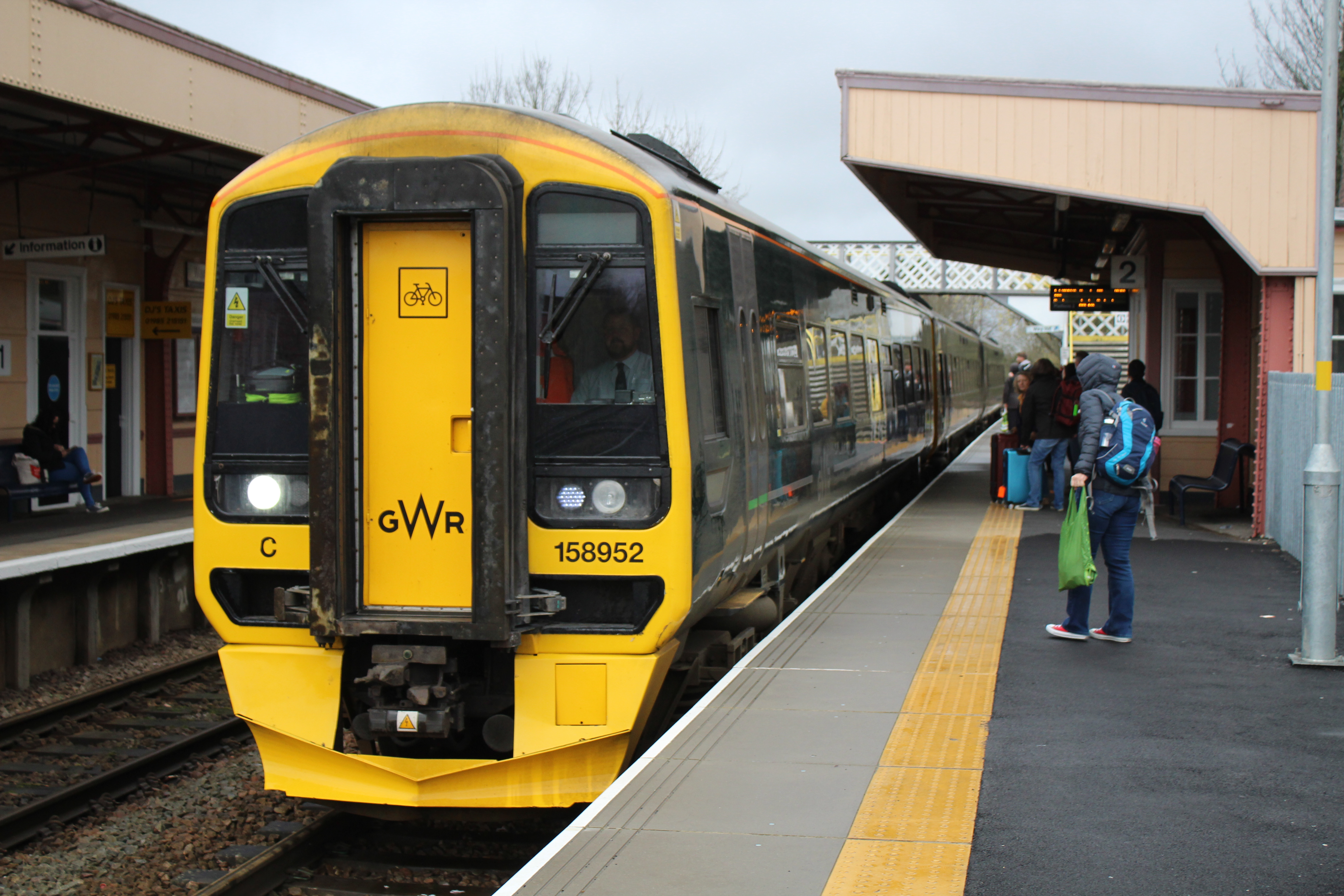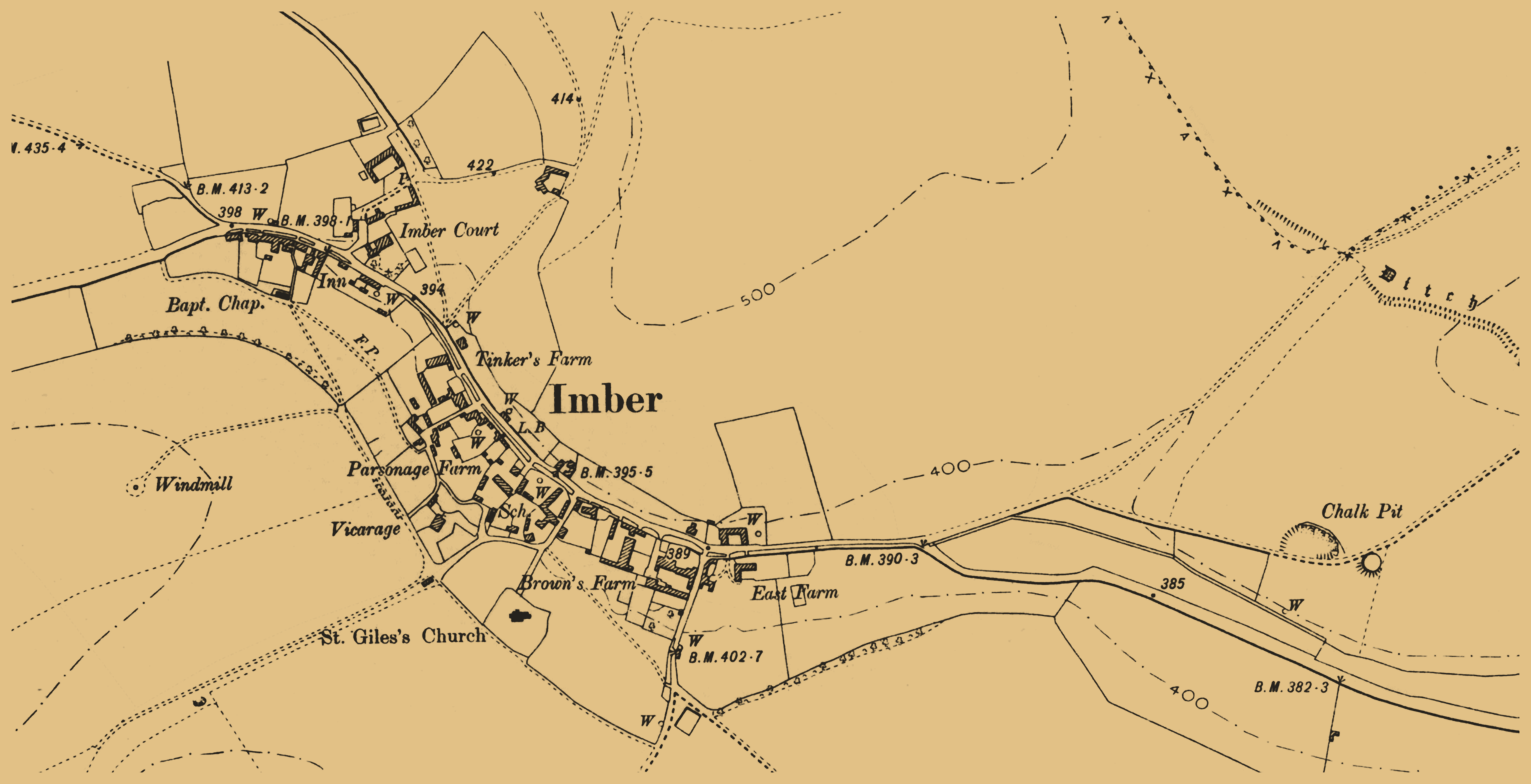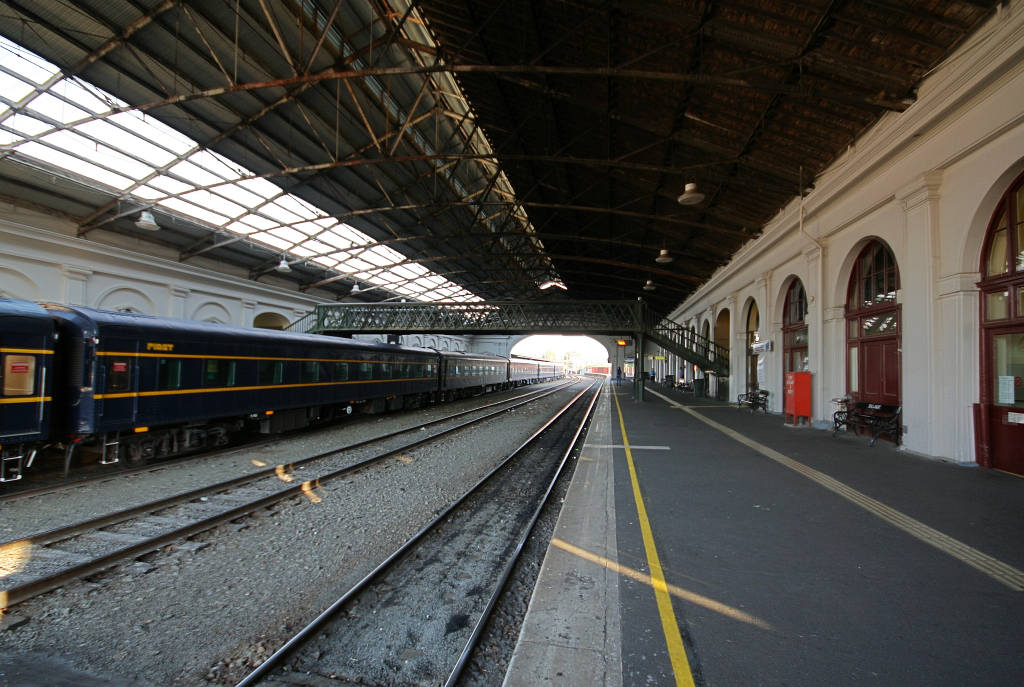|
Warminster Railway Station
Warminster railway station serves the town of Warminster in Wiltshire, England. The station is operated by Great Western Railway and is a main station on the Wessex Main Line, with regular services to Bristol, Cardiff, Southampton and Portsmouth. History The station was opened by the Great Western Railway on 9 September 1851 as the terminus of its branch from Westbury on its Wilts, Somerset and Weymouth route. The branch was extended to Salisbury on 30 June 1856. The station was originally provided with a train shed covering the tracks and platforms, but this was removed around 1930 when the current canopies were erected in its place. The original wooden buildings were retained and are still in use today. Services Great Western Railway operate a generally hourly service in each direction from the station, westbound to , and , and eastbound to and . A few additional GWR trains call at certain hours (some of which either originate or terminate here). Connect ... [...More Info...] [...Related Items...] OR: [Wikipedia] [Google] [Baidu] |
Warminster
Warminster () is an ancient market town with a nearby garrison, and civil parish in south west Wiltshire, England, on the western edge of Salisbury Plain. The parish had a population of about 17,000 in 2011. The 11th-century Minster Church of St Denys stands near the River Were, which runs through the town and can be seen running through the town park. The name Warminster first occurs in the early 10th century. The High Street and Market Place have many fine buildings including the Athenaeum Centre, the Town Hall, St Lawrence Chapel, and The Old Bell, and a variety of independent shops. Etymology The origin of the root ''Wor'' is ''wara'', the genitive plural of the Old English noun ''waru'' meaning "those that care for, watch, guard, protect, or defend." It was used as an endonym by both Goths and Jutes. Their specific ethnonym is unknown, though it likely was related to the native name of the oppidum at Battlesbury Camp during Sub-Roman times. The town's name has evolved ... [...More Info...] [...Related Items...] OR: [Wikipedia] [Google] [Baidu] |
Portsmouth Harbour Railway Station
Portsmouth Harbour railway station is a railway station in Portsmouth, England. It is situated beside Gunwharf Quays in the city's harbour, and is an important transport terminal, with a bus interchange and ferry services to Gosport and the Isle of Wight. The station currently has four platforms in use: numbered 1, 3, 4 and 5. It is managed by South Western Railway. Platform 2 is no longer in use, having been decommissioned in the early 1990s following major repair and refurbishment work to the pier that the platforms sit on. The station is located adjacent to Portsmouth Harbour between the Gunwharf Quays shopping centre and the Historic Dockyard. Unusually for a mainline railway station, it is built over water as the station was originally constructed on wooden piles, which were later replaced by iron supports. History The station opened on the 2nd October 1876 as the terminus of Chief Engineers Frederick Banister's Portsmouth Waterside Extension to the Portsmouth Dire ... [...More Info...] [...Related Items...] OR: [Wikipedia] [Google] [Baidu] |
Railway Stations Served By Great Western Railway
Rail transport (also known as train transport) is a means of transport that transfers passengers and goods on wheeled vehicles running on rails, which are incorporated in tracks. In contrast to road transport, where the vehicles run on a prepared flat surface, rail vehicles (rolling stock) are directionally guided by the tracks on which they run. Tracks usually consist of steel rails, installed on sleepers (ties) set in ballast, on which the rolling stock, usually fitted with metal wheels, moves. Other variations are also possible, such as "slab track", in which the rails are fastened to a concrete foundation resting on a prepared subsurface. Rolling stock in a rail transport system generally encounters lower frictional resistance than rubber-tyred road vehicles, so passenger and freight cars (carriages and wagons) can be coupled into longer trains. The operation is carried out by a railway company, providing transport between train stations or freight customer faciliti ... [...More Info...] [...Related Items...] OR: [Wikipedia] [Google] [Baidu] |
Railway Stations In Wiltshire
Rail transport (also known as train transport) is a means of transport that transfers passengers and goods on wheeled vehicles running on rails, which are incorporated in tracks. In contrast to road transport, where the vehicles run on a prepared flat surface, rail vehicles (rolling stock) are directionally guided by the tracks on which they run. Tracks usually consist of steel rails, installed on sleepers (ties) set in ballast, on which the rolling stock, usually fitted with metal wheels, moves. Other variations are also possible, such as "slab track", in which the rails are fastened to a concrete foundation resting on a prepared subsurface. Rolling stock in a rail transport system generally encounters lower frictional resistance than rubber-tyred road vehicles, so passenger and freight cars (carriages and wagons) can be coupled into longer trains. The operation is carried out by a railway company, providing transport between train stations or freight customer facil ... [...More Info...] [...Related Items...] OR: [Wikipedia] [Google] [Baidu] |
Railway Stations In Great Britain Opened In 1851
Rail transport (also known as train transport) is a means of transport that transfers passengers and goods on wheeled vehicles running on rails, which are incorporated in tracks. In contrast to road transport, where the vehicles run on a prepared flat surface, rail vehicles (rolling stock) are directionally guided by the tracks on which they run. Tracks usually consist of steel rails, installed on sleepers (ties) set in ballast, on which the rolling stock, usually fitted with metal wheels, moves. Other variations are also possible, such as "slab track", in which the rails are fastened to a concrete foundation resting on a prepared subsurface. Rolling stock in a rail transport system generally encounters lower frictional resistance than rubber-tyred road vehicles, so passenger and freight cars (carriages and wagons) can be coupled into longer trains. The operation is carried out by a railway company, providing transport between train stations or freight customer faciliti ... [...More Info...] [...Related Items...] OR: [Wikipedia] [Google] [Baidu] |
Former Great Western Railway Stations
A former is an object, such as a template, gauge or cutting die, which is used to form something such as a boat's hull. Typically, a former gives shape to a structure that may have complex curvature. A former may become an integral part of the finished structure, as in an aircraft fuselage, or it may be removable, being using in the construction process and then discarded or re-used. Aircraft formers Formers are used in the construction of aircraft fuselage, of which a typical fuselage has a series from the nose to the empennage, typically perpendicular to the longitudinal axis of the aircraft. The primary purpose of formers is to establish the shape of the fuselage and reduce the column length of stringers to prevent instability. Formers are typically attached to longerons, which support the skin of the aircraft. The "former-and-longeron" technique (also called stations and stringers) was adopted from boat construction, and was typical of light aircraft built until the a ... [...More Info...] [...Related Items...] OR: [Wikipedia] [Google] [Baidu] |
Imber
Imber is an uninhabited village within the British Army's training area on Salisbury Plain, Wiltshire, England. It lies in an isolated area of the Plain, about west of the A360 road between Tilshead and West Lavington. A linear village, its main street follows the course of a stream. Recorded in the Domesday Book of 1086, Imber was always an isolated community, several miles from any market town, and most of its men worked in agriculture or related trades. Beginning in the 1890s, the Ministry of Defence slowly bought up the village, and in 1943 the whole population of about 150 was evicted to provide an exercise area for American troops preparing for the invasion of Europe during the Second World War. After the war, the villagers were not allowed to return to their homes. The area of the former parish, which is now part of the civil parish of Heytesbury, remains under the control of the Ministry of Defence despite several attempts by former residents to return. Non-militar ... [...More Info...] [...Related Items...] OR: [Wikipedia] [Google] [Baidu] |
South Western Railway (train Operating Company)
First MTR South Western Trains Limited, trading as South Western Railway (SWR), is a British train operating company owned by FirstGroup (70%) and MTR Corporation (30%) that operates the South Western franchise. During March 2017, it was announced that SWR had been awarded the South Western franchise. On 20 August 2017, it took over operations from the previous franchisee South West Trains. SWR operates commuter services from its Central London terminus at London Waterloo railway station, London Waterloo to south west London. SWR provides suburban services in the counties of Surrey, Hampshire and Dorset, as well as regional services in Devon, Somerset, Berkshire and Wiltshire. Its subsidiary Island Line (train operating company), Island Line operates services on the Isle of Wight. Rolling stock changes have included a comprehensive refurbishment of existing units and the acquisition of new-build British Rail Class 701, Class 701 units from Bombardier Transportation, Bombardier ... [...More Info...] [...Related Items...] OR: [Wikipedia] [Google] [Baidu] |
GWR 158952 At Warminster
GWR may refer to: Transport * Great Western Railway, British railway company 1833–1947 * Great Western Railway (train operating company), British railway company (1996–) * Great Western Main Line, a railway line in the UK * Great Western Railway (other), other railway companies and routes with the name * Gloucestershire Warwickshire Railway, an English heritage railway * Aura Airlines (ICAO airline code: GWR), a Spanish airline * Gwinner–Roger Melroe Field (FAA airport code: GWR), Sargent County, North Dakota, USA Media * GWR Group, a defunct British commercial radio company, merged into GCap Media in 2005 **GWR FM (Bristol & Bath) ** GWR FM Wiltshire * GWR Records, a British record label * ''Graswurzelrevolution'', a German anarcho-pacifist magazine Other uses * Geographically weighted regression * Guinness World Records * Gwere language (ISO 639 language code: gwr) * Llygad Gŵr Llygad Gŵr (fl. 1268 or 1258 – c. 1293,) was a Welsh-language poet in the cour ... [...More Info...] [...Related Items...] OR: [Wikipedia] [Google] [Baidu] |
Train Shed
A train shed is a building adjacent to a station building where the tracks and platforms of a railway station are covered by a roof. It is also known as an overall roof. Its primary purpose is to store and protect from the elements train cars not in use, The first train shed was built in 1830 at Liverpool's Crown Street Station. The biggest train sheds were often built as an arch of glass and iron, while the smaller were built as normal pitched roofs. The train shed with the biggest single span ever built was that at the second Philadelphia Broad Street Station, built in 1891. Types of train shed Early wooden train sheds The earliest train sheds were wooden structures, often with unglazed openings to allow smoke and steam to escape. The oldest part of Bristol Temple Meads is a particularly fine – and large – example, designed by Isambard Kingdom Brunel with mock-hammerbeam roof. Surviving examples include: * Ashburton, Devon, England (station closed) *Bo'ness, Falki ... [...More Info...] [...Related Items...] OR: [Wikipedia] [Google] [Baidu] |
Wilts, Somerset And Weymouth Railway
The Wilts, Somerset and Weymouth Railway (WS&WR) was an early railway company in south-western England. It obtained Parliamentary powers in 1845 to build a railway from near Chippenham in Wiltshire, southward to Salisbury and Weymouth in Dorset. It opened the first part of the network but found it impossible to raise further money and sold its line to the Great Western Railway (GWR) in 1850. The GWR took over the construction and undertook to build an adjacent connecting line; the network was complete in 1857. In the early years of the 20th century the GWR wanted to shorten its route from London to the West of England and built "cut-off" lines in succession to link part of the WS&WR network, so that by 1906 the express trains ran over the Westbury to Castle Cary section. In 1933 further improvements were made, and that part of the line was established as part of the "holiday line" to Devon and Cornwall. The network was already a major trunk route for coal from South Wales coa ... [...More Info...] [...Related Items...] OR: [Wikipedia] [Google] [Baidu] |
Salisbury Branch Line (Great Western Railway)
The Salisbury branch line of the Great Western Railway from to Salisbury in Wiltshire, England, was completed in 1856. Most of the smaller stations were closed in 1955 but the line remains in use as part of the Wessex Main Line. History Wilts and Somerset Railway In 1844 the Great Western Railway (GWR) and the London and South Western Railway (LSWR) were engaged in a struggle to secure territory, known as the gauge war: the GWR lines were broad gauge and the LSWR were standard gauge, sometimes called "narrow gauge" for contrast. When the LSWR proposed a new line from Basingstoke to Newbury and Swindon, the GWR sought to fend it off with their own proposal, a branch line from their main line at Thingley Junction, west of Chippenham, to Salisbury. In this period the government's policy was that any general area could only support one railway line, and a commission appointed by the Board of Trade would appraise rival proposals and determine which should be permitted. In this cas ... [...More Info...] [...Related Items...] OR: [Wikipedia] [Google] [Baidu] |








